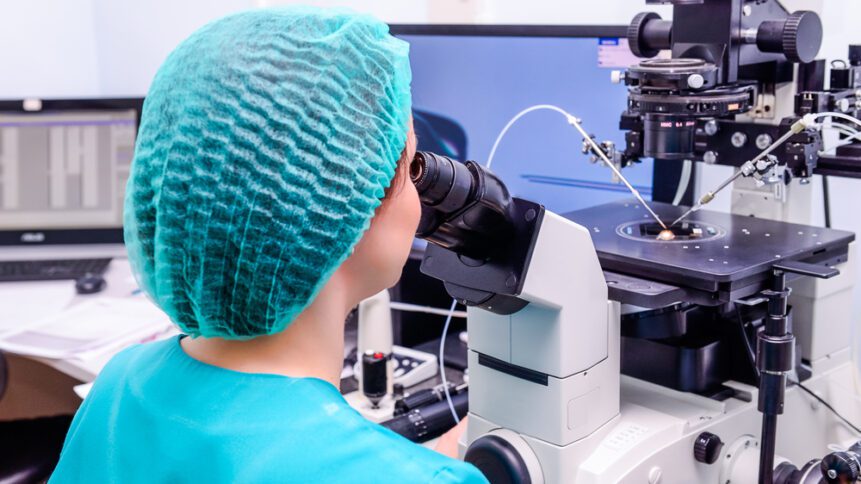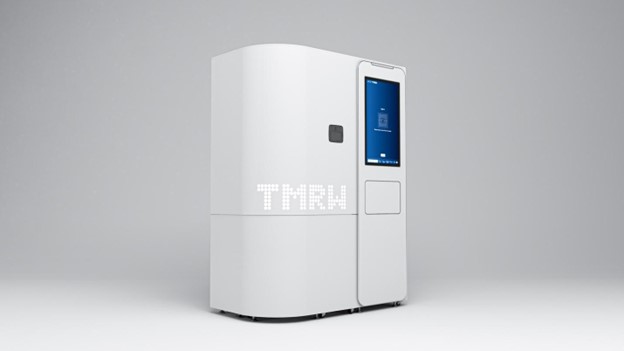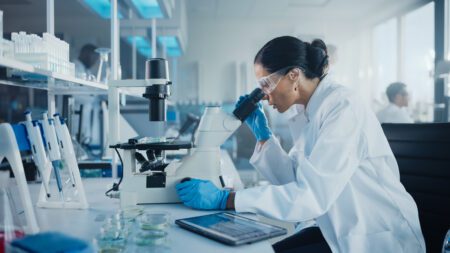
Presented by TMRW Life Sciences
When undergoing fertility treatments, choosing the right lab can make all the difference. From up-to-date technology and equipment to a wide variety of testing opportunities – the quality of the lab is key to ensuring access to comprehensive treatment options and care as you’re trying to build your family. When you’re in the throes of trying to build your family through assisted reproductive technology, not enough of us think about the quality of the lab, why it matters, or even what questions to ask.
What would it look like to consider the quality of the lab when choosing a clinic? What upgrades are labs making to ensure the highest quality care for their patients? And where is lab technology headed?
The process of building a family can be exhausting on every level – physically, emotionally, financially, and mentally. Another thing we may not think about, but that sadly has happened (as evidenced by the news headlines) is the possibility of error in the lab due to lack of technology and automation, which is the last thing you should have to deal with. Don’t get us wrong, we love and appreciate our labs and the hardworking embryologists and technicians behind the scenes – they’re brilliant miracle workers. But our labs need innovation – in terms of their equipment and technology, to ensure that you can access the best care and wide variety of treatment options and don’t have to worry about the safety and security of your specimens during an already draining process.
A Doctor Weighs In With What To Consider When Choosing A Clinic And A Lab
There are various factors that are critical to consider when selecting a fertility clinic: success rates, cost, location, and safety, to name a few. As clinics and labs continue to be overrun with a high supply of specimens, it is increasingly important to determine where the scientists, embryologists and health care providers will handle, freeze, manage, and store your fertility cells to ensure they are safe and accessible.
Dr. Tia Jackson-Bey, reproductive endocrinologist and infertility specialist with RMA of New York, explains: “A huge cornerstone of what we do rests on what happens in the lab. In science, there’s a concept called the ‘rate-limiting step,’ or the step in the chain of events that if it doesn’t work, you can’t proceed. I think of the lab as the rate-limiting step in IVF or other ART methods of building families. Labs are the gatekeepers of what is possible for so many of our treatments. Labs are so important for what happens on the clinical side – whether it’s how we rate the quality of embryos, what techniques and treatments we’ll consider, when to test, freeze, or transfer embryos, or inseminate. If we don’t have a high-quality lab, then we might not be able to get the high-quality results that we are hoping for.”
If we don’t have a high-quality lab, then we might not be able to get the high-quality results that we are hoping for.
Dr. Jackson also noted the very real limitations of cost, insurance, and geography as factors to consider when seeking treatment: “Infertility treatments can be cost-prohibitive for so many people. Infertility isn’t universally covered by health insurance. One major downside is that patients often try to choose where to get care based on cost, instead of based on clinical outcomes, quality of service, or options available. It’s a hard position to be in to even have to make those judgments or choices. We often see patients who initially went to other clinics because it was cost-effective, but they only got bare-bones care that was unsuccessful. It breaks my heart that sometimes people choose their clinics based on cost, not realizing that they may be sacrificing their chances at success. In fertility medicine, we talk to our patients about finances all the time. We’re always negotiating with insurance companies, figuring out payment plans, and even changing clinical treatment based on what someone may be able to afford, which is not how it should be. There’s also a lot of geographic restrictions. If there’s only one lab in your area and you have to drive two hours to get there, you may be limited. It’s imperative we increase access from a cost standpoint, and increase the level of high quality infertility care out there. We need labs in more places, and better technology that can help free up personnel to meet demand.”
Below are some examples of questions you may consider asking when choosing a fertility clinic:
- How much do your services typically cost?
- Does your clinic offer services to help negotiate with insurance companies, or create payment plans?
- How do you define success? And what are your success rates?
- Pro tip #1: Many clinics may define success via positive pregnancy tests. This rate can seem inflated, as compared to success rates of live births (which is a more helpful figure to base success off of, as the real goal here is a healthy baby).
- Pro tip #2: Be sure to ask about success rates for the specific treatment you are engaging in (e.g., IUI, IVF, etc.) compared against other patients around your age demographic.
- How many embryologists are a part of your clinic and what is their level of experience?
- Where are my eggs/embryos stored? Onsite or offsite? If offsite, how are they transported?
- Do you handwrite or digitally label, log, and track eggs/embryos?
- Do you manually or digitally monitor eggs/embryos?
- What safety measures are in place to ensure mix ups don’t occur?
- How do you prevent storage tank failures? Are there alarms that go off preemptively, or only when the problem is already occurring?
- Has your clinic ever had a specimen mix up or tank failure to date?
- Pro tip: This sometimes happens. If the answer is yes, you can follow up with, “What have you learned since that time? What changes have been made?”
- Will I have access to real-time data on the safety of my specimens?
If you are concerned about the effects of your state’s abortion laws on the safety of your specimens, you may also want to consider moving your eggs/embryos to be stored in a bio-repository in a state with safer abortion laws.
“More practices need to incorporate discussions about their labs, and how it all works behind the scenes,” Dr. Jackson encourages. “Transitioning to digital platforms will help us minimize human error. If basic technologies don’t seem like they’re being offered, that might be a red flag, or if you’re being pushed to do something that you’re not comfortable with, that could also be an opportunity to seek a second opinion.”
Labs Then And Now
For over 40 years, IVF technology has been pretty much the same. Most labs store all flash-frozen specimens in tanks that require clinicians to manually fill them with liquid nitrogen to maintain safe temperatures. Many clinics still use analog storage and labeling, and track on paper logs and spreadsheets, which can lead to confusion and occasional mix ups. Patients are increasingly interested in building their families with assisted reproductive technology, and fertility clinic labs haven’t generally been equipped with the tools to meet the demand.
The TMRW Difference
TMRW Life Sciences is responding to the need for a new standard of care for the frozen eggs and embryos used in IVF. Their mission is to safeguard life’s most precious cells. The company’s platform offers a new realm of safety for the frozen eggs and embryos used in IVF by creating unique digital identification, tracking, and transparency for a patient’s eggs or embryos. [TMRW Life Sciences] platform offers a new realm of safety for the frozen eggs and embryos used in IVF by creating unique digital identification, tracking, and transparency for a patient’s eggs or embryos.
The TMRW platform automates the process of caring for and storing eggs and embryos and introduces software-guided management of the cells used in IVF. The TMRW team is monitoring round-the-clock, performing proactive and continuous checks thousands of times daily. Their team reviews the trending data and anticipates changes in things like liquid nitrogen and temperature to ensure everything is running as it should be. When using TMRW’s technology, specimens are assigned a barcode, an ID number, and a unique RFID tag that provides an exact location of the egg or embryo when stored in the TMRW platform. TMRW’s tank also includes sensors, alarms, and notifications to ensure safety and 24/7 maintenance of cryogenic temperatures. With this technology and infrastructure, and a new app that will soon be available to patients, patients will be able to track where their eggs and embryos are stored.
Elizabeth Carr, Director of Marketing at TMRW explains, “For patients, TMRW’s technology provides transparent access, security, and peace of mind while on the journey to build a family. For health care professionals, TMRW’s platform is an enormous upgrade; it enables our providers to focus on what matters most: helping people build the family of their dreams.”
Danielle’s Story: Why I Shipped My Embryos to Another State
Danielle, a mother of two and former IVF patient living in Texas, shares her story with us about why lab quality is so important to her.
Danielle had her first daughter with no problems. However, when trying to conceive again she had two difficult miscarriages and was diagnosed with Secondary Infertility. Two rounds of IVF and about $25,000 later (even with insurance), Danielle brought home her second daughter and, like many new parents doing IVF, didn’t think much about the location of her remaining embryos.
Then Roe v Wade was overturned, which changed everything for Danielle. Danielle explains: “I found TMRW Life Sciences when Roe happened. I felt really uncomfortable living in Texas and storing my embryos here. What if I have another miscarriage, and I need medication to pass the deceased embryo? I can’t get that medication safely here. I posted on Instagram about being nervous about my embryos’ safety and wanting to transfer them out of state, and a friend of mine put me in touch with TMRW. I realized that I didn’t even know where my embryos were being stored. When you’re going through IVF, it’s emotional and things can move fast. You’re not necessarily thinking about where your embryos will be located.
At that point I realized that I didn’t even know where my embryos were being stored. When you’re going through IVF, it’s emotional and things can move fast. You’re not necessarily thinking about where your embryos will be located. All of sudden I called my clinic to find out their location – one person couldn’t find them, and the other person had no idea what I was talking about! Eventually someone called me a few hours later with information. I remember thinking, ‘Holy crap, I’d never thought about this and these are my possible future children, and we spent tens of thousands of dollars in this process. These embryos need to be in a safe place where they’re taken care of.’
For my living children, I always look into the best schools, best babysitters, and what the best foods are for them. If I’m taking such good care of my living children, I should really be looking into taking such good care of my future kids, too. Especially with all of the time and money we’ve put into these embryos! We don’t know that we necessarily want another child, but either way I want that to be our choice. If we decide not to have more children, we’ll donate the embryos to science.
I never thought I would live in a world where I’d have to move my embryos across state lines or have to think about which state to be in if I have another child. I hope these laws aren’t forever but they’re definitely for the foreseeable future. For anyone looking into IVF, be aware of your state laws.”
Staci & Emily’s Story: Loving Your Fertility Clinic, Including Its Lab
Staci and Emily Pambianchi are a gay couple in the process of trying to build their family via IVF. Their biggest piece of advice? Expect the unexpected.
Staci explains, “We started out not actually thinking we’d need IVF – we thought we’d just need IUI because we are a gay couple. But then we got genetic testing done and found out that I have a unique and severe genetic mutation, and a terminal deletion of half of my X chromosomes, so we went right into IVF after that. Testing is one of the best things that’s happened to us to prevent further loss of the embryos we’ve made. But even with testing, there’s no guarantee. The hardest part is waiting. Waiting for the labs to do their thing. Sometimes tests take longer than expected. The lab we use knows us well because I’m a frequent caller. We learned the detailed process of everything happening with our embryos through some of those calls.
For a new person starting out on their journey, I’d say, definitely get to know your lab. We were fortunate that our case was so unique that the labs really wanted us involved, but that doesn’t happen to everyone. It’s important to get to know the lab staff, because the process is so hard mentally and physically, and you may need that extra compassion. And not every lab is going to have that.”
When they initially started their journey, Emily reviewed a lot of clinics, and the labs they used. “That definitely helped reassure us – we did our research. We researched reviews and ensured there were good scientists on board. The first few things I asked were: What do you recommend I do? Are there lifestyle changes I could make to improve my chances? What type of treatments and options do you provide? How do you assess what someone would need for treatment? What does the process look like for each potential treatment option? Where will our eggs and embryos be stored? What does the timeline look like? Can you help me figure out my insurance? What are our odds and chances?”
Emily and Staci described their clinic as having a full team with a holistic approach to care. Their eggs and embryos are stored in a lab right on-site. Emily explains, “There’s access to support for billing, insurance, doctors, PAs, staff communicating on your behalf, geneticists, nutritionists, opportunities to connect and talk to current and former patients, groups, and more – they have a lot of resources. It can be so helpful to have that whole care team available for guidance on a journey that is so unknown and hard. Ultimately you have to take it one day at a time. And expect the unexpected.”
Staci continues, “My biggest piece of advice is to listen to your gut. If your gut is saying ‘I’m not going to be comfortable or I’m not sure,’ then it’s not for you. There are times where you need to advocate for yourself, whether it’s for particular testing or something else. We have been big advocates of listening to your gut and advocating to the clinics to ensure they listen. Even if you have the best clinic ever, and we feel like we do, it may still take more time than you anticipate.”
The Future of Lab Technology
A landmark study found that while risk-based events, such as a misplaced embryo record or an alarm malfunction, happen less than 1% of the time, the cost to remediate these events add up to significant financial burden for IVF clinics that rely on manual systems, which can be dramatically reduced through the use of automation.
And clearly the costs to patients who may be faced with damaged or misplaced embryos or eggs is too high and hard to measure.
TMRW is thinking about the future and how to store specimens as safely as possible for the long haul. TMRW now offers bio-repository services for patients and clinics alike. A bio-repository is a facility that collects, catalogs, and stores samples of biological material, whether for the purposes of an individual family’s needs, like Danielle’s, or scientific research. With their technology and automation, TMRW’s cryobanks in New York and soon in California will safely store fertility specimens for clinics and patients directly.
The TMRW integrated hardware and software system utilizes digital identification and tracking to check specimens into and out of storage, creating a secure specimen record and audit trail, providing a level of transparency to patients previously unavailable.
Many clinics have scores of legacy patients – patients who are storing specimens indefinitely. With TMRW managing an off-site volume of specimens, clinics are freed up on-site for short-term storage, and can enjoy expanded personnel capacity and services.
Carr explains, “TMRW’s Cryo Robot Select is modernizing management of eggs and embryos, leveraging technology to safeguard life’s most precious cells. It looks vending machine-like, with its transparent aesthetic, ease of accessibility, and touchscreen. The new CRS, which recently received its FDA clearance, will make it easier for clinics to maximize their storage options and meet demand for patient care.”

TMRW’s Cryo Robot Select is the only FDA-cleared automated solution that digitally tracks, monitors, and manages frozen eggs and embryos used in IVF.
Whether you are ready to undergo IVF, or are proactively storing eggs, sperm, or embryos to help safeguard and create your future family, the importance of lab quality and safety of your specimens cannot be understated.
Remember to always advocate for yourself (and for your frozen specimens!) by asking questions of your fertility clinic. A good practice will be happy to address your concerns and answer with transparency.
 This article is presented by TMRW, whose mission is to safeguard the world’s most precious cells for life and to provide clinics with the right tools and technology for their IVF labs. Learn more by visiting TMRW.ORG.
This article is presented by TMRW, whose mission is to safeguard the world’s most precious cells for life and to provide clinics with the right tools and technology for their IVF labs. Learn more by visiting TMRW.ORG.

Listen to stories, share your own, and get feedback from the community.


















